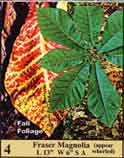|
TREES OF THE GREAT SMOKY MOUNTAINS |
|---|
|
Including: Great Smoky
Mountains National Park & Cherokee National Forest |
| 6 Page Laminated Guide |
| Outside 3 Pages Opens to 11" by 25" |
 |
|
TREES OF THE GREAT SMOKY MOUNTAINS |
|---|
|
Including: Great Smoky
Mountains National Park & Cherokee National Forest |
| 6 Page Laminated Guide |
| Outside 3 Pages Opens to 11" by 25" |
 |
| Outside Photo Page 8" by 11". Folds inside. |
Back Page | Front Page Folds to 8.5 by 11". |
|---|
|
|
|||
| Typical Species' Photos | |||
| (Actual size varies; including approximately 1.5" by 2.2" and 1.6" by 2.2") | |||
 |
 |
 |
 |
 |
The surrounding photos are representative of the 72 species photos contained in this guide. Most trees and even some shrubs found in and around the Park are included. Excluded are ornamentals (although some are included when they resemble native species) and trees considered rare and unlikely to be seen. The species' photos show as much visible information as possible, including seeds, fruit, trunks and fall color, if pertinent. |
|
| Photo Caption Information |
|---|
|
Under the common name, leaf characteristics and measurements are listed . The legend (in inches) is as follows: L=Length of leaf/needle, Ltl=Length of leaflet, W=Width of leaf, Wtl=Width of leaflet, C=Compound leaf, S=Simple leaf, A=Alternate leaf arrangement, O=Opposite leaf arrangement; Additional comments refer to needles or leaves. The Eastern Hemlock photo caption above says "(flattened, white under)" referring to the needles. |
|
|
|---|
| Inside 3 Pages Opens to 11" by 25" |
 |
|
|
||
| Text Blocks | ||
| (Actual size approximately 2.2" by 1.5" and 2.2" by 1.6") | ||
 |
 |
All three inside pages contain text blocks corresponding to each species pictured on the front. These provide family, common and scientific name, identification aids, behavior traits and often something of the species' role in nature and plant communities. Pages are arranged by tree distribution. |
| Sample of Sourwood Text | Sample of Eastern Hemlock Text |
|---|---|
|
Sourwood is easy to identify when its large terminal flower/fruit clusters are present but difficult without them due to the variability of its leaves. Helpful consistent traits include; alternate, solitary leaves with indented veining giving them a slight wavy look, a deeply furrowed trunk (like black locust), hairless twigs and a sour taste from chewed leaves (hence the common name). In our area, where it reaches its largest size, sourwood is most common on sunny semi-arid slopes. Usually found with chestnut and scarlet oaks, pine and black gum. Honey made from sourwood flowers is a delicacy. |
Has short flat needles usually in 2 opposite rows. Undersides possess 2 white lines (actually rows of tiny dots called stomata) which permit gas exchange with air. Typically, understory vegetation is sparse in hemlock forests due to its ability, through needle litter, to acidify the soil it grows on. This and hemlock's dense shade exclude most other species. Hemlock my be the longevity champion of eastern forests living 800-1000 years if unharvested. Although an important food resource, hemlock's main contribution to wildlife is the dense cover it provides for safety and shelter. |
| On Line Sales Outlet |
|---|
|